
Vernal Pools | An Overlooked Habitat
Tuesday, April 14, 2020
by: Tyler Frakes - Adirondack Council Membership Director
The Adirondack region contains a varied number of special habitats. You may be asking yourself... what is a habitat? A habitat is the home of an animal, plants or organism in which it lives or grows. Habitats are defined by the community of plants and animals that live together.
Some Adirondack habitats that are of great ecological importance include:
- the alpine zone which can only be found on a dozen mountain tops in the Adirondacks;
- hardwood forests that grow in rich, fertile soils and are home to sugar maples, beech, birch and other shade-tolerant trees and plants;
- lowland boreal forests that comprise many conifers such balsam fir, red and black spruce, and are home to spruce grouse (endangered in NYS); and,
- freshwater wetlands and aquatic habitat that include marshes, bogs, swamps, and fens.
Wetlands are hands down my favorite type of habitat in the Adirondacks. I grew up just a few blocks away from Wickham Marsh in Port Kent, New York, so, I may be a little biased! It was the go-to-place to see snakes, snapping turtles, birds of prey like osprey and bald eagles, cattails, pickerelweed, and water lilies.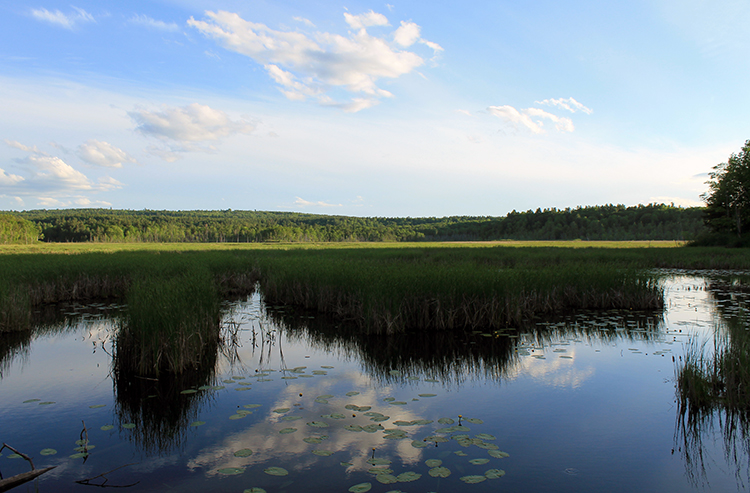 Wickham Marsh near Port Kent, NY
Wickham Marsh near Port Kent, NY
Wetlands are Important
Wetlands act like giant sponges of the Earth! When it rains, wetlands soak up water and help protect our lands from eroding during flooding events. Wetlands also filter out pollutants and control harmful levels of nitrogen and phosphorus that help keep our waters cleaner and clearer. Wetlands are also incredibly biodiverse (meaning they support lots of plants and animals) because they serve as a transition between land and water habitats. You get the best wildlife species from both habitats!
According to the Adirondack Park Agency, there are approximately 850,000 acres of wetlands in the Adirondacks, representing 14% of the six-million-acre Park. The presence of water and vegetation plays a key role in identifying wetlands and most are obvious to spot. Are there areas of standing water that you can see? Can you feel the soaked ground with your feet? Are there dead and decaying trees along a shoreline? If you answered yes to these questions, then it’s a good indication there might be a wetland present. Then again, some wetlands aren’t so obvious.
Seasonal, Temporary Wetland Habitat
Seasonal wetlands occur only when water levels are high during spring and winter and disappear completely come summer and fall. These seasonal wetlands, also known as vernal pools, vernal ponds or woodland pools, are often overlooked.
Vernal pools are small depressions on the forest floor with a layer of impermeable leaf litter, clay soil or bedrock that keeps water from draining away. Vernal pools are very shallow (less than four feet deep) and range from several feet to half an acre in size. They become filled with winter snow and spring rains and are generally stagnant with no inflow or outflow of freshwater occurring. During warmer months, these pools dry out completely. While on a spring hike you may have passed by large puddles in the forest without even recognizing it as a type of wetland habitat.
All wetlands play an important role in supporting human communities and wildlife. Vernal pools, although temporary, are especially important in providing both breeding and foraging areas for certain species of amphibians, reptiles, invertebrates, and insects. Some species even spend their entire lifecycle in vernal pools!
Breeding Habitat
Since vernal pools dry out, they are a fish-free habitat, thus allowing some species to reproduce without fear of predation. One amphibian that takes advantage of this fish-less habitat is the spotted salamander.
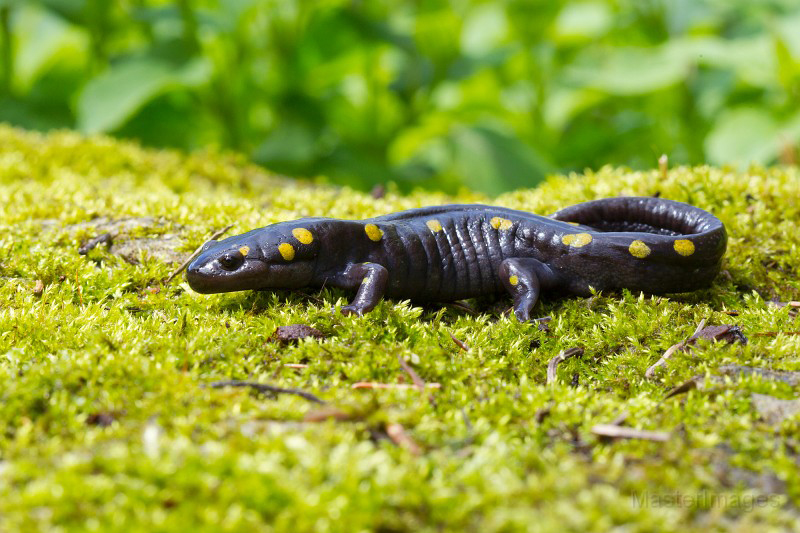 Spotted salamander (Ambystoma maculatum)
Spotted salamander (Ambystoma maculatum)
Spotted salamanders venture to seasonal pools in early spring (March-April) and lay a single large mass of eggs around vegetation. They prefer their eggs develop in pools with a lot of leaf-litter hiding spots. When late summer hits, their aquatic homes evaporate and immature adult salamanders become land lovers.
Other amphibians that may take advantage of breeding habitat created by vernal pools include wood frogs, spring peepers, red-spotted newts and four-toed salamanders.
Invertebrates such as insects, crustaceans and mollusks also breed in vernal pools. Fairy shrimp are crustaceans who's short life-cycle (just several weeks to reach maturity) is ideal for vernal pools. Yes, the relatives of lobsters and crabs can be found in the Adirondacks! These crustaceans are filter-feeders that dine on nutrient-rich algae, bacteria and broken-down leaves. Fairy shrimp hatch early to avoid becoming a regular food source and can even be spotted underneath ice-covered pools. Females lay hard-shelled eggs that can withstand the seasonal changes of vernal pools.
Some species of mollusks, including fingernail clams and air-breathing snails, also spend their entire life in woodland pools. If you spot their shells on the forest floor it’s a good indication there is a vernal pool present.
Foraging Habitat
While several species rely on vernal pools for breeding, they are also a great source of food for other wildlife. Fairy shrimp are preyed upon by salamanders and insects. Reptile species, including turtles and snakes, venture to vernal pools and wait at the edge for prey. Large numbers of unsuspecting tadpoles, salamander larvae and insects are a perfect food source for garter snakes.
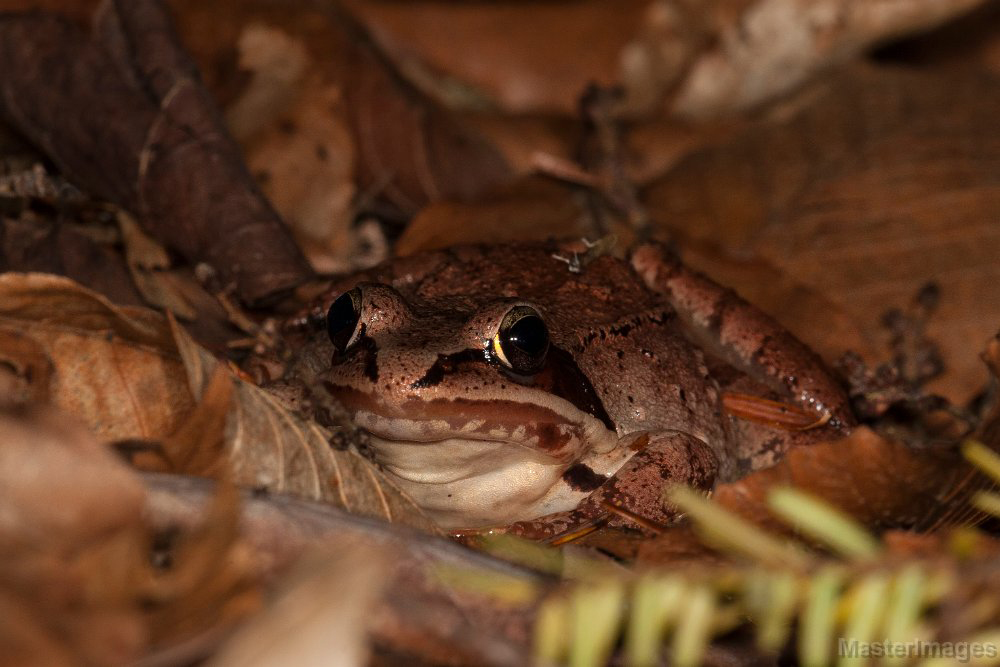 Wood Frog (Lithobates sylvatica)
Wood Frog (Lithobates sylvatica)
White-tail deer, turkeys, raccoons, and raptors also take advantage of the abundance of food found in seasonal pool habitats.
Habitat at Risk
Due to their small size and temporary presence, vernal pool wetlands are at risk from human activities like agriculture, road building and housing development. These activities fragment habitat and alter the natural hydrology (flow of water) that make these pools possible.
Severe drought events and increased precipitation as a result of climate change may impact the timing of when habitats may dry up or become inundated with water. A future with drastic changes in weather patterns may disrupt the breeding cycle of amphibians and foraging opportunities for their prey.
Habitat Conservation Efforts
Wetlands provide many benefits to our natural and human communities. If we don’t recognize the value of wetland habitat, we won't be able to preserve and manage them properly for future generations. Thankfully, public policy efforts and laws regarding the conservation and protection of wetlands exist at the federal, state and local levels of governance. Unfortunately, due to their small size and temporary nature, most vernal pools are not offered the same protection as other wetland habitats.
At the federal level, wetlands are regulated under section 404 of the Clean Water Act. The Act seeks to control and minimize activities like construction, dredging or filling that might significantly degrade wetlands and their inhabitants. Vernal pools must have significant connections to other waterbodies in order to be regulated by federal agencies like the Army Corps of Engineers and Environmental Protection Agency.
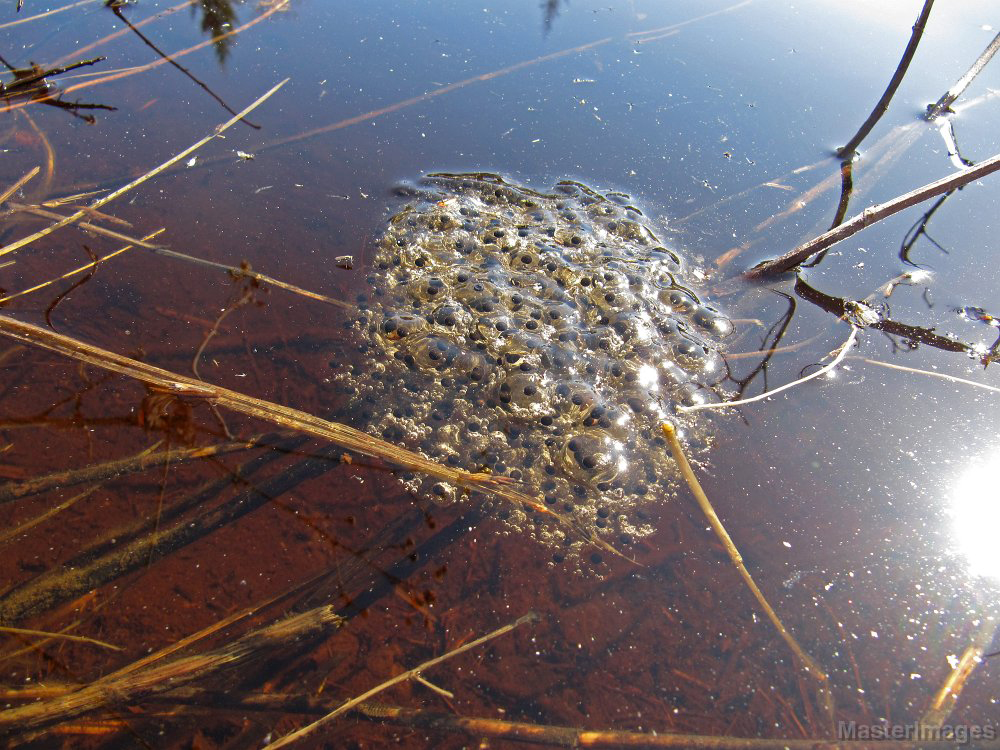 Wood Frog egg mass
Wood Frog egg mass
In New York, we are fortunate to have strong state laws and incentive programs that help conserve our wetlands. The state’s Freshwater Wetlands Act (FWA), Article 24 of the Environmental Conservation Law, gives the Department of Environmental Conservation and the Adirondack Park Agency (APA) the authority to regulate wetlands. The FWA states:
"It is declared to be the public policy of the state to preserve, protect and conserve freshwater wetlands and the benefits derived therefrom, to prevent the despoliation and destruction of freshwater wetlands, and to regulate use and development of such wetlands to secure the natural benefits of freshwater wetland, consistent with the general welfare and beneficial economic, social, and agricultural development of the state” (ECL Article 24-0103)
Wetlands over 12.4 acres in size and smaller wetlands that are of local significance are protected under the FWA. Wetlands in the Adirondack Park greater than one acre are mapped and regulated by the APA. Smaller wetlands are also under APA jurisdiction if they interconnect with surface waters. The APA Act defines wetlands as:
“any land which is annually subject to periodic or continual inundation by water and commonly referred to as a bog, swamp or marsh which are either (a) one acre or more in size or (b) located adjacent to a body of water, including a permanent stream, with which there is free interchange of water at the surface, in which case there is no size limitation.”
The APA defines wetlands by the type of vegetation present and gives each wetland a value grade that determines the level of activities that are permitted.
In New York State, the three +/- million-acre Adirondack Forest Preserve is vital in conserving vernal pool habitat. Article XIV of the State Constitution prohibits the development of the Forest Preserve and protects the wildlands that host vernal pools and their inhabitants.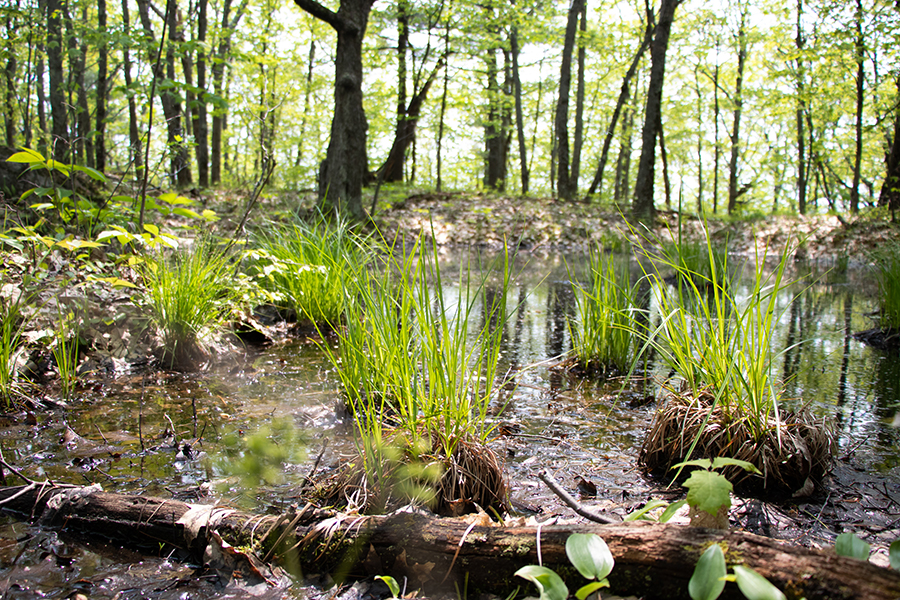 A Woodland Pool in the Adirondacks, also known as Vernal Pools or Vernal Ponds
A Woodland Pool in the Adirondacks, also known as Vernal Pools or Vernal Ponds
Local by-laws, land trusts and voluntary landowners who follow best management practices that minimize land disturbance, also help conserve vernal pool habitat. Private landowners can help by identifying existing or potential habitat, creating a buffer zone, managing the surrounding forest, maintaining connections to other habitat, setting conservation goals, and planning for future land-use.
Our freshwater wetlands are important for our natural and human communities in providing habitat and clean water. Public awareness and a greater recognition of the importance of vernal pools and other wetlands will determine the success of future conservation efforts in the Adirondacks and elsewhere.
So, the next time you are on a spring hike in the Adirondacks you might spot a large pool of water on the forest floor. Don’t forget to stop and explore! But do so, carefully. You might be surprised at what wildlife you discover in these temporary habitats galore.
|
||||





